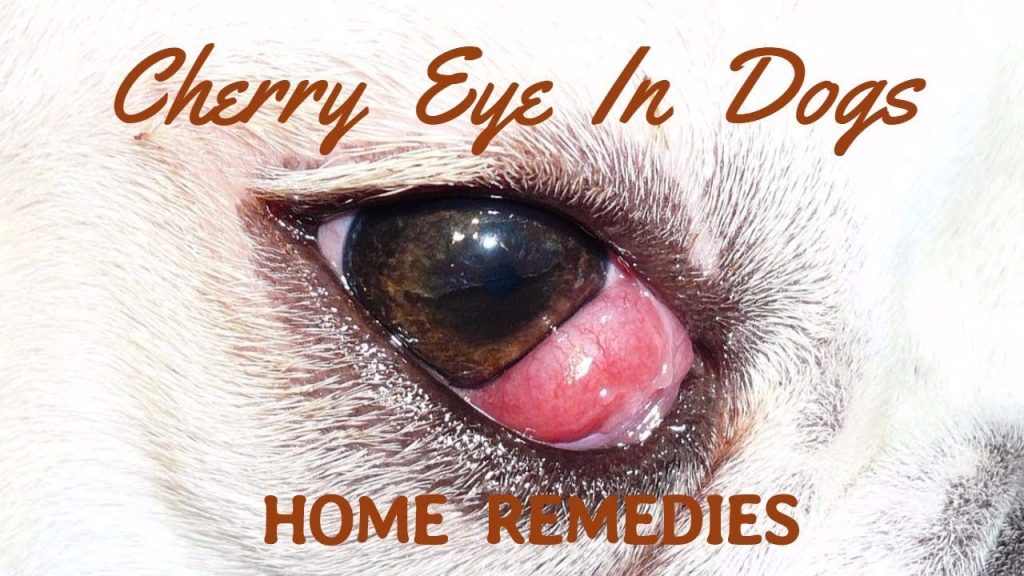
Cherry eye is a common condition that affects dogs, particularly certain breeds like Bulldogs and Cocker Spaniels. It is characterized by a pink, fleshy mass protruding from the corner of the dog’s eye, resembling a cherry. While it may not be a life-threatening condition, it can cause discomfort and potential complications if left untreated. Fortunately, there are home treatments available that can help alleviate the symptoms and prevent further complications.
But what exactly causes cherry eye in dogs? How can you identify the condition and distinguish it from other eye problems? In this article, we will dive into the world of cherry eye, exploring its causes, symptoms, and most importantly, how you can effectively treat it at home. Whether you are a concerned dog owner or simply intrigued by these fascinating canine health issues, stay tuned to discover the secrets of cherry eye home treatment!
Dealing with Cherry Eye in dogs at home can be a challenging and distressing experience for pet owners. One of the main concerns is the discomfort it causes to the dog. The swollen and protruding gland in the eye can lead to irritation, redness, and excessive tearing, making the dog visibly uncomfortable. Additionally, the condition can become a cosmetic issue, affecting the dog’s appearance and potentially leading to self-esteem issues for the owner. Moreover, finding an effective home treatment for Cherry Eye can be frustrating, as there is no one-size-fits-all solution. Pet owners may have to try different remedies, such as warm compresses or gentle massage, while also dealing with the uncertainty of whether these treatments will provide long-term relief.
In the article discussing home treatment options for Cherry Eye in dogs, several key points are highlighted. Firstly, it emphasizes the importance of promptly seeking veterinary advice to ensure an accurate diagnosis and appropriate treatment plan. It suggests that early intervention can help prevent complications and reduce the discomfort experienced by the dog. The article then explores various home remedies that can be used in conjunction with veterinary guidance, such as using warm compresses to alleviate inflammation and gently massaging the affected area. Furthermore, it mentions the significance of maintaining a clean environment for the dog to prevent secondary infections. Lastly, the article mentions related keywords like dog eye health, eye care for dogs, and common eye conditions in dogs, indicating the broader scope of information available on this topic. Overall, the article provides a comprehensive overview of home treatment options for Cherry Eye in dogs, highlighting the importance of considering both veterinary guidance and home remedies to alleviate the discomfort experienced by our beloved pets.
Cherry Eye in Dogs: Home Treatment
As devoted pet owners, we always strive to provide the best care for our furry companions. However, sometimes unexpected health issues arise, and being aware of potential problems can help us address them promptly. One such condition that can affect our beloved dogs is known as cherry eye. It is a term used to describe the prolapse or protrusion of the third eyelid gland, giving it a swollen and reddish appearance resembling a cherry. While this condition is more common in certain dog breeds, such as Bulldogs, Beagles, and Cocker Spaniels, it can occur in any breed at any age. If your dog develops cherry eye, you may be wondering about home treatment options to alleviate their discomfort and restore their eye’s normal appearance.
Understanding Cherry Eye and Its Causes
To effectively treat cherry eye at home, it is important to understand its causes and underlying factors. The third eyelid gland, also known as the nictitating membrane, plays a crucial role in producing tears and providing additional protection to the eye. When this gland prolapses, it becomes visible and creates the characteristic cherry-like appearance. The exact cause of cherry eye is not fully understood, but it is believed to be a combination of genetic predisposition and weakened connective tissues that hold the gland in place. Additionally, factors such as eye irritation, allergies, or eye infections can contribute to the development of cherry eye.
Recognizing the Symptoms of Cherry Eye
Identifying cherry eye early on is essential for successful home treatment. The most obvious symptom is the red, swollen mass protruding from the corner of the affected eye. This can be quite alarming for pet owners. Other signs may include excessive tearing, squinting, rubbing or pawing at the eye, and potential discomfort or pain. It is crucial to consult your veterinarian for a proper diagnosis and confirmation of cherry eye, as other eye conditions may have similar symptoms.
Consulting with Your Veterinarian
While home treatment can help manage cherry eye, it is important to consult with your veterinarian before attempting any remedies. They will be able to assess the severity of the condition and provide guidance on the most appropriate course of action. In some cases, surgical intervention may be necessary to correct the issue. However, in mild cases or as a preliminary step, your veterinarian may recommend trying home treatment methods first.
Home Treatment Options for Cherry Eye
When it comes to addressing cherry eye at home, there are several techniques and remedies that can be effective in reducing the swelling and promoting healing. It’s important to note that these methods should only be attempted under the guidance of your veterinarian.
1. Warm Compresses
Using warm compresses is a simple yet effective way to alleviate discomfort and reduce inflammation associated with cherry eye. Begin by soaking a clean cloth or cotton ball in warm water, making sure it is not too hot to avoid burning your dog’s delicate eye area. Gently hold the compress against the affected eye for a few minutes at a time, repeating this process several times a day. The warmth will increase blood circulation, promote drainage, and aid in reducing the swelling.
2. Massage
Massaging the area around the prolapsed gland can help stimulate blood flow and encourage the gland to retract. Ensure that your hands are clean and gently use your fingertips to apply light pressure in circular motions around the swollen area. Be cautious not to apply excessive force or cause any discomfort to your dog. Massaging can be done during warm compress sessions to further enhance the benefits.
3. Eye Drops or Ointments
Your veterinarian may prescribe eye drops or ointments that can help alleviate irritation and reduce inflammation. These medications are typically formulated to soothe the eye, promote healing, and prevent infections. It is crucial to strictly follow your veterinarian’s instructions regarding dosage and administration to ensure the best outcome for your dog.
4. Dietary Supplements
Incorporating certain dietary supplements into your dog’s daily routine may aid in strengthening the connective tissues around the eye and reducing the chances of cherry eye recurring. Omega-3 fatty acids, such as fish oil, have anti-inflammatory properties and can contribute to overall eye health. Always consult with your veterinarian before adding any supplements to your dog’s diet to ensure they are safe and appropriate for your pet.
5. Herbal Remedies
Some pet owners have found success in using herbal remedies to address cherry eye. However, it is crucial to exercise caution when considering these options, as not all herbs are safe for dogs. Aloe vera gel, when applied topically, can have soothing properties and assist in reducing inflammation. Chamomile tea, when cooled down, can be used as a gentle eyewash to provide relief and promote healing. Before using any herbal remedies, consult with your veterinarian to ensure they are safe and suitable for your dog.
Knowing When to Seek Veterinary Intervention
While home treatment methods can be effective in managing cherry eye, it is essential to monitor your dog’s progress closely. If the swelling and redness persist or worsen after a few days of home treatment, it is crucial to seek veterinary intervention. Your veterinarian may recommend surgical correction if the gland fails to retract on its own or if the condition is severe. Surgery is often a permanent solution to prevent future occurrences of cherry eye.
The Importance of Preventive Measures
Preventing cherry eye in dogs can be challenging due to its partly genetic nature. However, there are several measures that pet owners can take to potentially reduce the risk. Regularly cleaning your dog’s eyes with a damp cloth or specialized pet wipes can help maintain good eye hygiene and minimize the chances of eye infections or irritations. Avoid exposing your dog to environments with excessive dust, smoke, or other potential irritants. Additionally, providing a balanced and nutritious diet can contribute to overall eye health and strength.
In conclusion, while cherry eye can be a distressing condition for both dogs and their owners, there are home treatment options available to alleviate discomfort and aid in recovery. Understanding the causes, recognizing the symptoms, and consulting with your veterinarian are crucial steps in determining the best course of action. With proper care, attention, and guidance, you can effectively manage cherry eye in your beloved furry friend, ensuring their eyes remain healthy and vibrant for years to come.
Cherry Eye In Dogs Home Treatment
Cherry eye in dogs is a common condition that occurs when the tear gland in the third eyelid becomes inflamed and protrudes from the eye. While surgical intervention is often necessary to correct this issue, there are some home treatments that can help alleviate symptoms and potentially prevent the need for surgery.One of the most effective home treatments for cherry eye in dogs is the use of warm compresses. Applying a warm compress to the affected eye several times a day can help reduce inflammation and promote healing. Simply soak a clean washcloth in warm water and gently place it over the eye for 5-10 minutes. This can be done multiple times throughout the day to provide relief for your furry friend.Another home treatment option for cherry eye in dogs is the use of natural remedies such as chamomile tea. Chamomile has anti-inflammatory properties and can help soothe the eye. Brew a cup of chamomile tea and allow it to cool. Then, use a sterile cotton ball to apply the cooled tea to the affected eye. This can be done a few times a day to help reduce swelling and promote healing.In addition to warm compresses and natural remedies, it is important to keep your dog’s eyes clean and free of debris. Gentle cleaning with a saline solution or an eye wash specifically designed for dogs can help prevent further irritation and infection. Be sure to follow the instructions on the product and use a clean cotton ball or soft cloth to gently wipe the eye.While these home treatments may provide temporary relief for cherry eye in dogs, it is important to consult with a veterinarian for a proper diagnosis and treatment plan. In some cases, surgery may be necessary to fully correct the issue and prevent long-term complications. Your vet will be able to determine the best course of action for your dog based on their individual needs.
Listicle: Cherry Eye In Dogs Home Treatment
1. Warm compresses: Apply a warm compress to the affected eye several times a day to reduce inflammation and promote healing.2. Chamomile tea: Brew a cup of chamomile tea, allow it to cool, and use a sterile cotton ball to apply it to the eye. Chamomile has anti-inflammatory properties and can help soothe the eye.3. Keep the eyes clean: Use a saline solution or an eye wash specifically designed for dogs to gently clean the eyes and remove debris.4. Consult with a veterinarian: While home treatments may provide temporary relief, it is important to consult with a vet for a proper diagnosis and treatment plan. Surgery may be necessary in some cases.5. Follow the vet’s advice: Your vet will be able to recommend the best course of action for your dog based on their individual needs. Follow their instructions and monitor your dog’s progress closely.Remember, while home treatments may provide temporary relief for cherry eye in dogs, it is important to seek professional veterinary care for a proper diagnosis and long-term treatment plan.
Question and Answer: Cherry Eye In Dogs Home Treatment
Q1: What is cherry eye in dogs?
A1: Cherry eye is a condition in dogs where the gland located in the third eyelid becomes inflamed and protrudes, resembling a red, cherry-like mass in the corner of the eye. It can occur in one or both eyes.
Q2: Can cherry eye be treated at home?
A2: While it is recommended to consult a veterinarian for proper diagnosis and treatment, there are some home remedies that may help alleviate mild cases of cherry eye. However, it is important to note that these remedies may not guarantee complete resolution of the condition.
Q3: What are some home treatments for cherry eye in dogs?
A3: Some home treatments for cherry eye in dogs include gently massaging the protruding gland back into place using a warm compress, applying a sterile lubricant to keep the eye moist, and using over-the-counter saline eye drops to reduce inflammation. These methods should only be attempted under veterinary guidance.
Q4: When should I seek veterinary help for cherry eye in dogs?
A4: It is crucial to seek veterinary assistance if your dog develops cherry eye, as early intervention can prevent further complications. A veterinarian will be able to provide a proper diagnosis and recommend appropriate treatment options, which may involve medication or surgical intervention.
Conclusion of Cherry Eye In Dogs Home Treatment
In conclusion, while there are some home remedies that may provide temporary relief for cherry eye in dogs, it is always best to consult a veterinarian for an accurate diagnosis and appropriate treatment. Home treatments should only be used under veterinary guidance and may not fully resolve the condition. Seeking timely veterinary help can ensure the well-being and long-term eye health of your furry companion.
Thank you so much for visiting our blog today to learn more about home treatment options for cherry eye in dogs. We hope that the information we provided has been helpful and informative for you. As dog owners ourselves, we understand how concerning it can be to see your furry friend dealing with this condition, and we want to assure you that there are steps you can take at home to help alleviate their discomfort.
First and foremost, it is important to consult with your veterinarian before attempting any home treatments. They will be able to provide you with a proper diagnosis and guidance on the best course of action for your specific dog. In some cases, surgery may be necessary to correct the cherry eye, but in others, home treatment methods can be effective.
One home treatment option you can try is the use of warm compresses. This can help to reduce any swelling and inflammation associated with the cherry eye. Simply soak a clean cloth in warm water and gently place it over your dog’s affected eye for a few minutes, several times a day. This can provide some relief and promote healing.
Another home remedy that may be beneficial is the use of eye drops or ointments. Your veterinarian can recommend the most appropriate product for your dog’s condition. These medications can help to lubricate the eye and reduce any irritation or dryness that may be present. It is important to follow the instructions provided by your vet and administer the medication as directed.
In conclusion, while cherry eye in dogs can be a concerning condition, there are home treatment options available that can help to alleviate symptoms and promote healing. However, it is crucial to consult with your veterinarian before attempting any treatments at home. They will be able to provide you with the most accurate diagnosis and guidance on the best course of action for your beloved pet. Remember, your dog’s health and wellbeing should always be your top priority!
Thank you once again for visiting our blog. We hope that you found this information helpful and that your dog finds relief from their cherry eye soon. If you have any further questions or concerns, please do not hesitate to reach out to us. Wishing you and your furry friend all the best!





